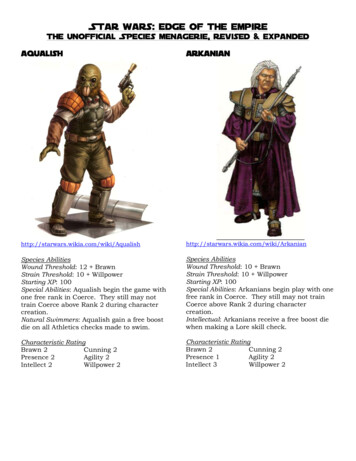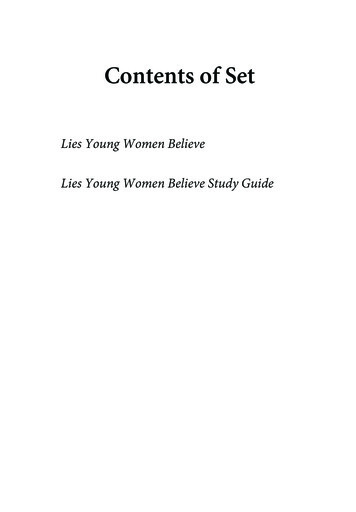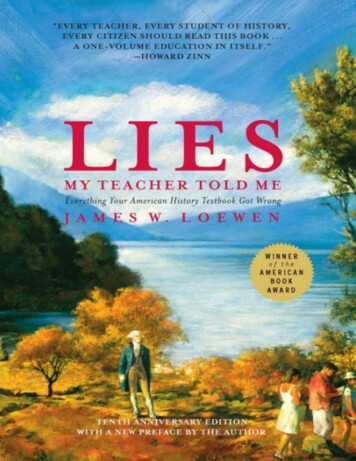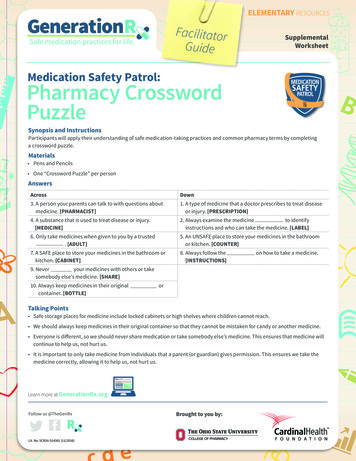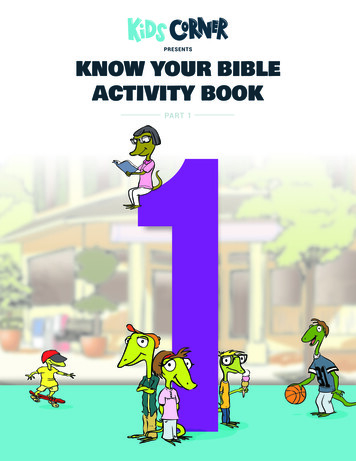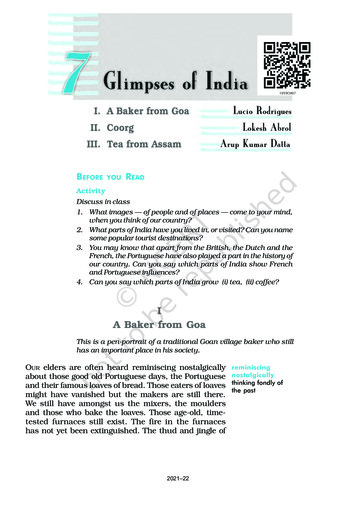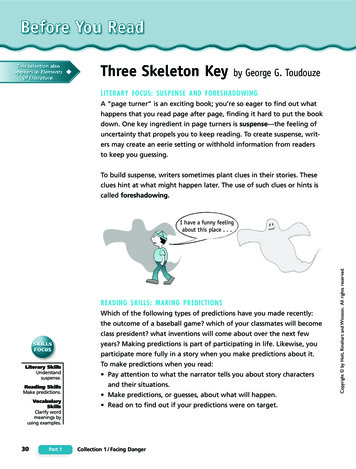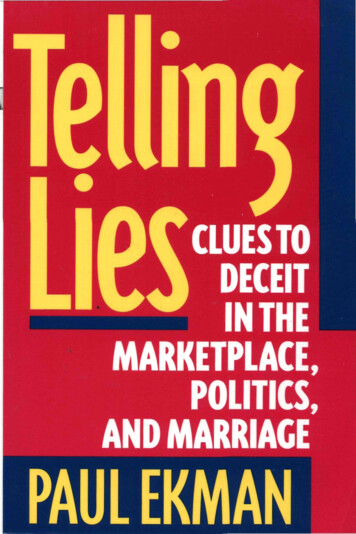
Transcription
PsychologyTelling LiesPAUL EKMAN"This admirable book offers both a wealth of detailed, practical information aboutlying and lie detection and a penetrating analysis of the ethical implications ofthese behaviors. It is strongly recommended to physicians, lawyers, diplomats andall those who must concern themselves with detection of deceit."—Jerome D. FrankThe Johns Hopkins University School of MedicineIn this new expanded edition of the author's pathfinding inquiry into the world ofliars and lie catching, Paul Ekman, a world-renowned expert in emotions researchand nonverbal communication, brings, in two new chapters, his much-publicizedfindings on how to detect lies to the real world.In new Chapter 9, "Lie Catching in the 1990s," the author reveals that most ofthose to whom we have attributed an ability to detect lies—judges, trial lawyers,police officers, polygraphers, drug enforcement agents, and others—perform nobetter on lie-detecting tests than ordinary citizens, that is, no better than chance.In addition, he cites the case of Lt. Col. Oliver North and Vice Admiral JohnPoindexter during the Iran/contra scandal congressional hearings, to demonstratehis judicious use of behavioral clues to detect lies.In Chapter 10, "Lies in Public Life," he incorporates many more real-worldcase studies—from lying at the presidential level (Richard Nixon and Watergate,and Lyndon Johnson and the Vietnam War) to self-deception in the space shuttleChallenger disaster and the 1991 Senate judiciary hearings on alleged sexualharassment of Anita Hill by Supreme Court nominee Clarence Thomas—to delineate further his lie-detecting methods as well as to comment on the place of lies inpublic life.Paul Ekman is professor of psychology at the University of California, SanFrancisco.Cover design bv Andrew M. Newman Graphic Design
Telling Lies
ALSO BY PAUL EKMANEmotion in the Human Face (with W. V. Friesen & P. Ellsworth)Darwin and Facial Expression (editor)Unmasking the face (with W. V. Friesen)Facial Action Coding System (with W. V. Friesen)Face of ManHandbook of Methods in Nonverbal Behavior Research (co-editor, with KlausScherer)Approaches to Emotion (co-editor, with Klaus Scherer)Why Kids Lie (with Mary Ann Mason & Tom Ekman)
PAUL EKMANTelling LiesClues to Deceit in theMarketplace, Politics, and MarriageW W - N O R T O N & COMPANY -New York-London
Copyright 1992, 1985 by Paul Ekman. All rights reserved.Printed in the United States of America.First published as a Norton paperback 1991.Excerpts from Marry Me, by John Updike, are reprinted by permission ofAlfred A. Knopf, Inc. Copyright 1971, 1973, 1976, by John Updike.Photographs on pages 295, 297, 310, 316, 318 courtesy of AP/Wide WorldPhotos.The text of this book is composed in Janson, with display type set in Caslon.Composition by The Haddon Craftsmen, Inc.Library of Congress Cataloging in Publication DataEkman, Paul.Telling Lies.Includes bibliographical references and index.1. Truthfulness and falsehood. Psychology. I. Title.BJ1421.E36 1985 153.6 84-7994ISBN 0-393-30872-3W. W. Norton & Company, Inc.500 Fifth Avenue, New York, N. Y. 10110W. W. Norton & Company Ltd10 Coptic Street, London WClA 1PU4567890
In Memory ofErving Goffman,Extraordinary Friend and Colleagueand for my wife,Mary Ann Mason,Critic and Confidante
When the situation seems to be exactly what it appears to be, theclosest likely alternative is that the situation has been completelyfaked; whenfakery seems extremely evident, the next most probablepossibility is that nothing fake is present.—Erving Goffman,Strategic InteractionThe relevant framework is not one of morality but of survival. Atevery level, from brute camouflage to poetic vision, the linguisticcapacity to conceal, misinform, leave ambiguous, hypothesize, invent is indispensable to the equilibrium of human consciousness andto the development of man in society. . . .—George Steiner, AfterBabelIf falsehood, like truth, had only one face, we would be in bettershape. For we would take as certain the opposite of what the liarsaid. But the reverse of truth has a hundred thousand shapes anda limitless field.—Montaigne, Essays
ContentsAcknowledgments11ONE Introduction15TWO Lying, Leakage, and Clues to Deceit25THREEFOUR Why Lies Fail43 Detecting Deceit From Words, Voice,or BodyFIVE Facial Clues to DeceitSIX Dangers and Precautions80123162SEVEN T h e Polygraph as Lie Catcher190EIGHT Lie Checking240NINE Lie Catching in the 1990sTEN Lies in Public Life279299
10ContentsEpilogue325Appendix331Reference Notes341Index351
Acknowledgmentsto the Clinical Research Branch of theNational Institute of Mental Health for supportingmy research on nonverbal communication from 1963through 1981 (MH11976). The Research Scientist AwardProgram of the National Institute of Mental Health hassupported both the development of my research programover most of the past twenty years and the writing of thisbook (MH 06092). I wish to thank the Harry F. Guggenheim Foundation and the John D. and Catherine T.MacArthur Foundation for supporting some of the research described in chapters 4 and 5. Wallace V. Friesen,with whom I have worked for more than twenty years, isequally responsible for the research findings that I reportin those chapters; many of the ideas developed in the bookcame up first in our two decades of dialogue.I thank Silvan S. Tomkins, friend, colleague, andteacher, for encouraging me to write this book, and for hiscomments and suggestions about the manuscript. I benefited from the criticisms of a number of friends who readthe manuscript from their different vantage points: RobertBlau, a physician; Stanley Caspar, a trial lawyer; Jo Carson,a novelist; Ross Mullaney, a retired FBI agent; RobertPickus, a political thinker; Robert Ornstein, a psychologist;and Bill Williams, a management consultant. My wife,IAM GRATEFUL
12AcknowledgmentsMary Ann Mason, my first reader, was patient and constructively critical.I discussed many of the ideas in the book with ErvingGoffman, who had been interested in deceit from quite adifferent angle and enjoyed our contrasting but not contradictory views. I was to have had the benefit of his comments on the manuscript, but he died quite unexpectedlyjust before I was to send it. The reader and I lose by theunfortunate fact that our dialogue could only occur in mymind.
Telling Lies
ONEIntroductionT IS September 15, 1938, and one of the most infamousand deadly of deceits is about to begin. Adolf Hitler,the chancellor of Germany, and Neville Chamberlain,the prime minister of Great Britain, meet for the first time.The world watches, aware that this may be the last hopeof avoiding another world war. (Just six months earlierHitler's troops had marched into Austria, annexing it toGermany. England and France had protested but donenothing further.) On September 12, three days before he isto meet Chamberlain, Hitler demands to have part ofCzechoslovakia annexed to Germany and incites rioting inthat country. Hitler has already secretly mobilized the German Army to attack Czechoslovakia, but his army won't beready until the end of September.If he can keep the Czechs from mobilizing their armyfor a few more weeks, Hitler will have the advantage of asurprise attack. Stalling for time, Hitler conceals his warplans from Chamberlain, giving his word that peace can bepreserved if the Czechs will meet his demands. Chamberlain is fooled; he tries to persuade the Czechs not to mobilize their army while there is still a chance to negotiate withHitler. After his meeting with Hitler, Chamberlain writesto his sister, ". . . in spite of the hardness and ruthlessnessI thought I saw in his face, I got the impression that hereI
16Telling Lieswas a man who could be relied upon when he had given hisword. . . ." ] Defending his policies against those who doubtHitler's word, Chamberlain five days later in a speech toParliament explains that his personal contact with Hitlerallows him to say that Hitler "means what he says."2When I began to study lies fifteen years ago I had noidea my work would have any relevance to such a lie. Ithought it would be useful only for those working withmental patients. My study of lies began when the therapistsI was teaching about my findings—that facial expressionsare universal while gestures are specific to each culture—asked whether these nonverbal behaviors could reveal thata patient was lying.3 Usually that is not an issue, but itbecomes one when patients admitted to the hospital because of suicide attempts say they are feeling much better.Every doctor dreads being fooled by a patient who commitssuicide once freed from the hospital's restraint. Their practical concern raised a very fundamental question abouthuman communication: can people, even when they arevery upset, control the messages they give off, or will theirnonverbal behavior leak what is concealed by their words?I searched my films of interviews with psychiatric patients for an instance of lying. I had made these films foranother purpose—to isolate expressions and gestures thatmight help in diagnosing the severity and type of mentaldisorders. Now that I was focusing upon deceit, I thoughtI saw signs of lying in a number of films. The problem washow to be certain. In only one case was there no doubt—because of what happened after the interview.Mary was a forty-two-year-old housewife. The last ofher three suicide attempts was quite serious. It was only anaccident that someone found her before an overdose ofsleeping pills killed her. Her history was not much different from that of many other women who suffer a midlifedepression. The children had grown up and didn't need
Introduction17her. Her husband seemed preoccupied with his work.Mary felt useless. By the time she had entered the hospitalshe no longer could handle the house, could not sleep well,and sat by herself crying much of the time. In her first threeweeks in the hospital she received medication and grouptherapy. She seemed to respond very well: her mannerbrightened, and she no longer talked of committing suicide.In one of the interviews we filmed, Mary told the doctorhow much better she felt and asked for a weekend pass.Before receiving the pass, she confessed that she had beenlying to get it. She still desperately wanted to kill herself.After three more months in the hospital Mary had genuinely improved, although there was a relapse a year later.She has been out of the hospital and apparently well formany years.The filmed interview with Mary fooled most of theyoung and even many of the experienced psychiatrists andpsychologists to whom I showed it.4 We studied it for hundreds of hours, going over it again and again, inspectingeach gesture and expression in slow-motion to uncover anypossible clues to deceit. In a moment's pause before replying to her doctor's question about her plans for the future,we saw in slow-motion a fleeting facial expression of despair, so quick that we had missed seeing it the first fewtimes we examined the film. Once we had the idea thatconcealed feelings might be evident in these very briefmicro expressions, we searched and found many more, typically covered in an instant by a smile. We also found a microgesture. When telling the doctor how well she was handlingher problems Mary sometimes showed a fragment of ashrug—not the whole thing, just a part of it. She wouldshrug with just one hand, rotating it a bit. Or, her handswould be quiet but there would be a momentary lift of oneshoulder.We thought we saw other nonverbal clues to deceit, but
18Telling Lieswe could not be certain whether we were discovering orimagining them. Perfectly innocent behavior seems suspicious if you know someone has lied. Only objective measurement, uninfluenced by knowledge of whether a personwas lying or telling the truth, could test what we found.And, many people had to be studied for us to be certain thatthe clues to deceit we found are not idiosyncratic. It wouldbe simpler for the person trying to spot a lie, the lie catcher,if behaviors that betray one person's deceit are also evidentwhen another persons lies; but the signs of deceit might bepeculiar to each person. We designed an experiment modeled after Mary's lie, in which the people we studied wouldbe strongly motivated to conceal intense negative emotionsfelt at the very moment of the lie. While watching a veryupsetting film, which showed bloody surgical scenes, ourresearch subjects had to conceal their true feelings of distress, pain, and revulsion and convince an interviewer,who could not see the film, that they were enjoying a filmof beautiful flowers. (Our findings are described in chapters 4 and 5).Not more than a year went by—when we were still atthe beginning stages of our lying experiments—before people interested in quite different lies sought me out. Couldmy findings or methods be used to catch Americans suspected of being spies? Over the years, as our findings onbehavioral clues to deceit between patient and doctor werepublished in scientific journals, the inquiries increased.How about training those who guard cabinet officers sothey could spot a terrorist bent on assassination from hisgait or gestures? Can we show the FBI how to train policeofficers to spot better whether a suspect is lying? I was nolonger surprised when asked if I could help summitnegotiators spot their opponents' lies, or if I could tell fromthe photographs of Patricia Hearst taken while she participated in a bank hold-up if she was a willing or unwilling
Introduction19robber. In the last five years the interest has become international. I have been approached by representatives of twocountries friendly to the United States; and, when I lectured in the Soviet Union, by officials who said they werefrom an "electrical institute" responsible for interrogations.I was not pleased with this interest, afraid my findingswould be misused, accepted uncritically, used too eagerly.I felt that nonverbal clues to deceit would not often beevident in most criminal, political, or diplomatic deceits. Itwas only a hunch. When asked, I couldn't explain why. Todo so I had to learn why people ever do make mistakes whenthey lie. Not all lies fail. Some are performed flawlessly.Behavioral clues to deceit—a facial expression held toolong, a missing gesture, a momentary turn in the voice—don't have to happen. There need be no telltale signs thatbetray the liar. Yet I knew that there can be clues to deceit.The most determined liars may be betrayed by their ownbehavior. Knowing when lies will succeed and when theywill fail, how to spot clues to deceit and when it isn't worthtrying, meant understanding how lies, liars, and lie catchers differ.Hitler's lie to Chamberlain and Mary's to her doctorboth involved deadly serious deceits, in which the stakeswere life itself. Both people concealed future plans, andboth put on emotions they didn't feel as a central part oftheir lie. But the differences between their lies are enormous. Hitler is an example of what I later describe as anatural performer. Apart from his inherent skill, Hitlerwas also much more practiced in deceit than Mary.Hitler also had the advantage of deceiving someonewho wanted to be misled. Chamberlain was a willing victim who wanted to believe Hitler's lie that he did not planwar if only the borders of Czechoslovakia were redrawn tomeet his demands. Otherwise Chamberlain would have
20Telling Lieshad to admit that his policy of appeasement had failed andin fact weakened his country. On a related matter, thepolitical scientist Roberta Wohlstetter made this point inher analysis of cheating in arms races. Discussing Germany's violations of the Anglo-German Naval Agreementof 1936, she said: ". . . the cheater and the side cheated. . . have a stake in allowing the error to persist. They bothneed to preserve the illusion that the agreement has notbeen violated. The British fear of an arms race, manipulated so skillfully by Hitler, led to a Naval Agreement, inwhich the British (without consulting the French or theItalians) tacitly revised the Versailles Treaty; and London'sfear of an arms race prevented it from recognizing or acknowledging violations of the new agreement." 5In many deceits the victim overlooks the liar's mistakes,giving ambiguous behavior the best reading, collusivelyhelping to maintain the lie, to avoid the terrible consequences of uncovering the lie. By overlooking the signs ofhis wife's affairs a husband may at least postpone the humiliation of being exposed as a cuckold and the possibility ofdivorce. Even if he admits her infidelity to himself he maycooperate in not uncovering her lies to avoid having toacknowledge it to her or to avoid a showdown. As long asnothing is said he can still have the hope, no matter howsmall, that he may have misjudged her, that she may not behaving an affair.Not every victim is so willing. At times, there is nothing to be gained by ignoring or cooperating with a lie.Some lie catchers gain only by exposing a lie and if they doso lose nothing. The police interrogator only loses if he istaken in, as does the bank loan officer, and both do their jobwell only by uncovering the liar and recognizing the truthful. Often, the victim gains and loses by being misled or byuncovering the lie; but the two may not be evenly balanced.Mary's doctor had only a small stake in believing her lie.
Introduction21If she was no longer depressed he could take some creditfor effecting her recovery. But if she was not truly recovered he suffered no great loss. Unlike Chamberlain, thedoctor's entire career was not at stake; he had not publiclycommitted himself, despite challenge, to a judgment thatcould be proven w r o n g if he uncovered her lie. He hadmuch more to lose by being taken in than he could gain ifshe was being truthful. In 1938 it was too late for Chamberlain. If Hitler were u n t r u s t w o r t h y , if there was no way tostop his aggression short of war, then Chamberlain's careerwas over, and the war he thought he could prevent wouldbegin.Quite apart from Chamberlain's motives to believe Hitler, the lie was likely to succeed because no strong emotionshad to be concealed. Most often lies fail because some signof an emotion being concealed leaks. T h e stronger the emotions involved in the lie, and the greater the n u m b e r ofdifferent emotions, the more likely it is that the lie will bebetrayed by some form of behavioral leakage. Hitler certainly would not have felt guilt, an emotion that is doublyproblematic for the liar—not only may signs of it leak, butthe torment of guilt may motivate the liar to make mistakesso as to be caught. Hitler would not feel guilty about lyingto the representative of the country that had in his lifetimeimposed a humiliating military defeat on G e r m a n y . UnlikeMary, Hitler did not share important social values with hisvictim; he did not respect or admire him. Mary had toconceal strong emotions for her lie to succeed. She had tosuppress the despair and anguish motivating her suicidewish. And, Mary had every reason to feel guilty about lyingto her doctors: she liked them, admired them, and knewthey only wanted to help her.For all these reasons and more it usually will be fareasier to spot behavioral clues to deceit in a suicidal patientor a lying spouse than in a diplomat or a double agent. But
22Telling Liesnot every diplomat, criminal, or intelligence agent is a perfect liar. Mistakes are sometimes made. The analyses I havemade allow one to estimate the chances of being able to spotclues to deceit or being misled. My message to those interested in catching political or criminal lies is not to ignorebehavioral clues but to be more cautious, more aware of thelimitations and the opportunities.While there is some evidence about the behavioral cluesto deceit, it is not yet firmly established. My analyses ofhow and why people lie and when lies fail fit the evidencefrom experiments on lying and from historical and fictionalaccounts. But there has not yet been time to see how thesetheories will weather the test of further experiment andcritical argument. I decided not to wait until all the answers are in to write this book, because those trying tocatch liars are not waiting. Where the stakes for a mistakeare the highest, attempts already are being made to spotnonverbal clues to deceit. "Experts" unfamiliar with all theevidence and arguments are offering their services as liespotters in jury selection and employment interviews.Some policemen and professional polygraphers using the"lie detector" are taught about the nonverbal clues to deceit. About half the information in the training materialsI have seen is wrong. Customs officials attend a specialcourse in spotting the nonverbal clues of smuggling. I amtold that my work is being used in this training, but repeated inquiries to see the training materials have onlybrought repeated promises of "we'll get right back to you."It is also impossible to know what the intelligence agenciesare doing, for their work is secret. I know they are interested, for the Defense Department six years ago invited meto explain to them what I thought were the opportunitiesand the hazards. Since then I have heard rumors that workis proceeding, and I have picked up the names of some ofthe people who may be involved. My letters to them have
Introduction23gone unanswered, or the answer given is that I can't be toldanything. I worry about "experts" who go unchallenged bypublic scrutiny and the carping critics of the scientific community. This book will make clear to them and those forwhom they work my view of both the hazards and theopportunities.My purpose in writing this book is not to address onlythose concerned with deadly deceits. I have come to believethat examining how and when people lie and tell the truthcan help in understanding many human relationships.There are few that do not involve deceit or at least thepossibility of it. Parents lie to their children about sex tospare them knowledge they think their children are notready for, just as their children, when they become adolescents, will conceal sexual adventures because the parentswon't understand. Lies occur between friends (even yourbest friend won't tell you), teacher and student, doctor andpatient, husband and wife, witness and jury, lawyer andclient, salesperson and customer.Lying is such a central characteristic of life that betterunderstanding of it is relevant to almost all human affairs.Some might shudder at that statement, because they viewlying as reprehensible. I do not share that view. It is toosimple to hold that no one in any relationship must ever lie;nor would I prescribe that every lie be unmasked. Advicecolumnist Ann Landers has a point when she advises herreaders that truth can be used as a bludgeon, cruelly inflicting pain. Lies can be cruel too, but all lies aren't. Some lies,many fewer than liars will claim, are altruistic. Some socialrelationships are enjoyed because of the myths they preserve. But no liar should presume too easily that a victimdesires to be misled. And no lie catcher should too easilypresume the right to expose every lie. Some lies are harmless, even humane. Unmasking certain lies may humiliatethe victim or a third party. But all of this must be consid-
24Telling Liesered in more detail, and after many other issues have beendiscussed. The place to begin is with a definition of lying,a description of the two basic forms of lying, and the twokinds of clues to deceit.
TWOLying, Leakage,and Clues to DeceitRESIGNINGas president, RichardNixon denied lying but acknowledged that he, likeother politicians, had dissembled. It is necessary towin and retain public office, he said. "You can't say whatyou think about this individual or that individual becauseyou may have to use him. . . . you can't indicate youropinions about world leaders because you may have to dealwith them in the future." 1 Nixon is not alone in avoidingthe term lie when not telling the truth can be justified.* Asthe Oxford English Dictionary tells us: "in modern use, theword [lie] is normally a violent expression of moral reprobation, which in polite conversation tends to be avoided,IGHT YEARS AFTERE"Attitudes may be changing. Jody Powell, former President Carter's press secretary, justifies certain lies: "From the first day the first reporter asked the firsttough question of a government official, there has been a debate about whethergovernment has the right to lie. It does. In certain circumstances, government notonly has the right but a positive obligation to lie. In four years in the White HouseI faced such circumstances twice." He goes on to describe an incident in whichhe lied to spare "great pain and embarrassment for a number of perfectly innocent people." The other lie he acknowledged was in covering the military plansto rescue the American hostages from Iran (Jody Powell, The Other Side of the Story,New York: William Morrow & Co., Inc., 1984).
26Telling Liesthe synonyms falsehood and untruth being often substitutedas relatively euphemistic." 2 It is easy to call an untruthfulperson a liar if he is disliked, but very hard to use that term,despite his untruthfulness, if he is liked or admired. Manyyears before Watergate, Nixon epitomized the liar to hisDemocratic opponents—"would you buy a used car fromthis man?"—while his abilities to conceal and disguise werepraised by his Republican admirers as evidence of politicalsavvy.These issues, however, are irrelevant to my definitionof lying or deceit. (I use the words interchangeably.) Manypeople—for example, those who provide false informationunwittingly—are untruthful without lying. A woman whohas the paranoid delusion that she is Mary Magdalene is nota liar, although her claim is untrue. Giving a client badinvestment advice is not lying unless the advisor knewwhen giving the advice that it was untrue. Someone whoseappearance conveys a false impression is not necessarilylying. A praying mantis camouflaged to resemble a leaf isnot lying, any more than a man whose high forehead suggested more intelligence than he possessed would belying.*A liar can choose not to lie. Misleading the victim isdeliberate; the liar intends to misinform the victim. The liemay or may not be justified, in the opinion of the liar or thecommunity. The liar may be a good or a bad person, likedor disliked. But the person who lies could choose to lie or"It is interesting to guess about the basis of such stereotypes. The high foreheadpresumably refers, incorrectly, to a large brain. The stereotype that a thin-lippedperson is cruel is based on the accurate clue that lips do narrow in anger. Theerror is in utilizing a sign of a temporary emotional state as the basis for judginga personality trait. Such a judgment implies that thin-lipped people look that waybecause they are narrowing their lips in anger continuously; but thin lips can alsobe a permanent, inherited facial feature. The stereotype that a thick-lipped person is sensual in a similar way misconstrues the accurate clue that lips thicken,engorged with blood during sexual arousal, into an inaccurate judgment abouta permanent trait; but again, thick lips can be a pemanent facial feature.'
Lying, Leakage, and Clues to Deceit27to be truthful, and knows the difference between the two.4Pathological liars who know they are being untruthful butcannot control their behavior do not meet my requirement.Nor would people who do not even know they are lying,those said to be victims of self-deceit.* A liar may comeover time to believe in her own lie. If that happens shewould no longer be a liar, and her untruths, for reasons Iexplain in the next chapter, should be much harder todetect. An incident in Mussolini's life shows that belief inone's own lie may not always be so beneficial: ". . . in 1938the composition of [Italian] army divisions had been reduced from three regiments to two. This appealed to Mussolini because it enabled him to say that fascism had sixtydivisions instead of barely half as many, but the changecaused enormous disorganisation just when the war wasabout to begin; and because he forgot what he had done,several years later he tragically miscalculated the truestrength of his forces. It seems to have deceived few otherpeople except himself."5It is not just the liar that must be considered in defininga lie but the liar's target as well. In a lie the target has notasked to be misled, nor has the liar given any prior notification of an intention to do so. It would be bizarre to callactors liars. Their audience agrees to be misled, for a time;that is why they are there. Actors do not impersonate, asdoes the con man, without giving notice that it is a pose puton for a time. A customer would not knowingly follow theadvice of a broker who said he would be providing convincing but false information. There would be no lie if thepsychiatric patient Mary had told her doctor she would beclaiming feelings she did not have, any more than Hitler"While I do not dispute the existence of pathological liars and individuals whoare victims of self-deceit, it is difficult to establish. Certainly the liar's wordcannot be taken as evidence. Once discovered, any liar might make such claimsto lessen punishment.
28Telling Liescould have told Chamberlain not to trust his promises.In my definition of a lie or deceit, then, one personintends to mislead another, doing so deliberately, withoutprior notification of this purpose, and without having beenexplicitly asked to do so by the target.* There are twoprimary ways to lie: to conceal and to falsify.6 In concealing,the liar withholds some information without actually saying anything untrue. In falsifying, an additional step istaken. Not only does the liar withhold true information,but he p
findings on how to detect lies to the real world. In new Chapter 9, "Lie Catching in the 1990s," the author reveals that most of those to whom we have attributed an ability to detect lies—judges, trial lawyers, police officers, pol
